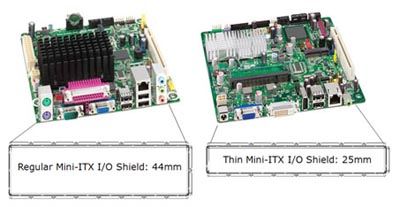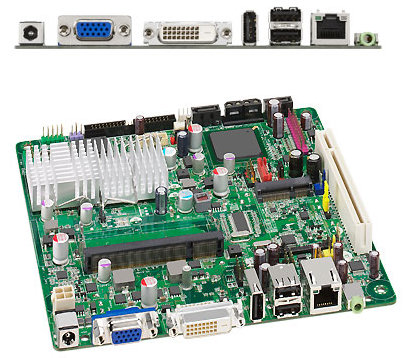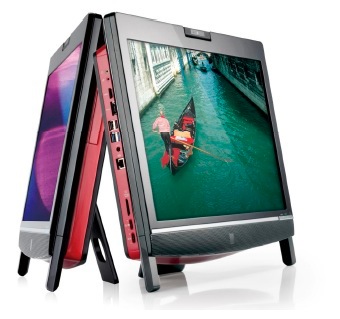Thin Mini-ITX boards will cut device costs, Intel says
Mar 3, 2011 — by LinuxDevices Staff — from the LinuxDevices Archive — 56 viewsAll-in-one PCs, ATMs, gaming machines, and other embedded devices could be set for a price cut, thanks to a new motherboard format being promoted by Intel. “Thin Mini-ITX” boards, set for broad availability in mid-2011, will bring standardization to products that previously required custom solutions, the chipmaker says.
According to Intel, all-in-one PCs (AIOs) are a fast-growing segment in the desktop market, but there have been no standards for this form factor so far. AIOs are built with custom motherboards, custom thermal solutions, and, in many cases, custom power supplies — all of which drive up the cost of building such systems, according to the company.
The chip giant says it will address this problem this year by promoting broad availability of Thin Mini-ITX motherboards. These devices will retain the 6.7 x 6.7-inch footprint of the Mini-ITX format first developed by Via Technologies in 2002, but, as pictured below, their I/O shield will be just under an inch high (25mm) instead of 1.73 inches (44mm).

Standard Mini-ITX (left) and Thin Mini-ITX (right)
Such thinner boards will work well not only for AIOs, but also for other form factors, such as thin media PCs, VESA-mounted PCs, or PCs for vertical usages such as hospital carts, ATMs, and casino gaming machines, Intel says. And, the company adds, because Thin Mini-ITX boards can also fit into existing desktop Mini-ITX cases, the market for them will be broad (and costs correspondingly low).
According to Intel, other key features that make up a Thin Mini-ITX motherboard will include:
- support for desktop CPUs up to 65-Watt TDP
- internal display connectors for LVDS or eDP (embedded DisplayPort)
- SODIMM memory support
- external power supply (through back I/O panel)
- Mini PCI Express expansion
Intel did not announce further specifics of its own planned Thin Mini-ITX boards. However, the device shown earlier in this story appears to be the D945GSEJT (below), a board that's already available with Intel's Atom N270 and 945GSE chipset on board.

Intel's existing D945GSEJT appears to be the company's first Thin Mini-ITX board
According to a DigiTimes item that appeared today regarding Intel's initiative, the chipmaker is working with Taiwan-based vendors including Elitegroup Computer Systems (ECS), Mitac, and Micro-Star Intermational (MSI) to promote the Thin Mini-ITX format. Meanwhile, Mitac used this week's CeBit show in Hanover to show off the Maestro 650 (below), an AIO that uses a Thin Mini-ITX board fitted with one of Intel's "Sandy Bridge" Core processors.

Mitac's Maestro 650
Mitac says the Maestro 650 (above) may be opened up with just one screw, allowing resellers, system integrators, and DIY enthusiasts to "leverage its friendly design for interchangeable and interoperable components." Other features include a 21.5-inch LED-backlit screen, an "ECO" button that can decrease screen brightness and adjust operating frequency, a proximity sensor, and an HDMI input, according to the company.
Zane Ball, an Intel general manager for desktop platforms, stated:
We are thrilled to see that MiTAC is utilizing the Intel Thin Mini-ITX board standard as the basis for their Maestro series of all-in-one PCs. By utilizing standard system components, MiTAC is making the AIO desktop more accessible to channel system integrators worldwide. We look forward to continued innovation in this exciting and important new category of AIO PCs.
Further information
More information on Thin Mini-ITX, including a design guide and motherboard specifications, may be found on Intel's Thin Mini-ITX page.
This article was originally published on LinuxDevices.com and has been donated to the open source community by QuinStreet Inc. Please visit LinuxToday.com for up-to-date news and articles about Linux and open source.